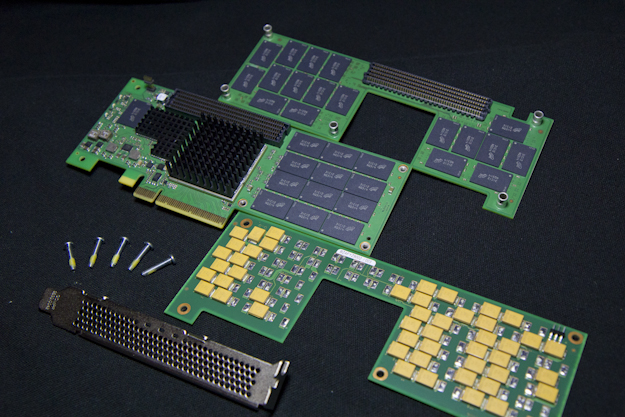Micron sent us the P420m sans the black plastic cover that goes over the power-loss capacitors. With the internals exposed, we have a trio of boards, each with a specific purpose. The first board has the flash controller which is covered by a large heat sink. By ever so gently prying the heat sink off, we were able to see what makes this drive tick. As a side note, this process most definitely voided our warranty.
Even though the controller was produced by IDT, Micron had a heavy hand in its development and its firmware. The controller has 32 channels, and in this iteration, support for 64 NAND packages.
Moving through the board, we have 9 DRAM chips. Each DDR3 chip has a capacity of 256MB, giving us a total of 2.25GB.
The P420m utilizes 25nm MLC NAND; a departure from the SLC NAND used on the P320h. Each NAND package is made up of 8 die, with each die comprising 32Gb. The NAND is spread across 64 packages on two PCBs.
The P420m 1.4TB has a total of 2048GB of NAND. As we outlined in the P320h review, Micron’s RAIN technology uses 12.5% of that capacity for redundancy. RAIN allows for on the fly recovery of die failures, which is a great feature for enterprise customers. This leaves the P420m, just like the P320h, with ~22% over-provisioning.
Finally, the P420m, offers power-loss protection in the way of capacitors located on the third circuit board. This is the a new feature that the P320h did not have.
 The SSD Review The Worlds Dedicated SSD Education and Review Resource |
The SSD Review The Worlds Dedicated SSD Education and Review Resource | 


Great review. Did you know tweaktown got Sandisk’s A110 PCIe SSD to review?
Yes…as well as Tom’s. It sometimes works like that and, if you stay tuned, you may see an exclusive M.2 report in the near future that we were lucky to grab.
page four, blue graph at the bottom (4K Read Steady State, 1 Hr at QD256) shows “LATENCY (ms)” in the left vertical axis name with values from 700.000 to 800.000.
Obviously it’s NOT latency, but it is IOPS which is really fantastic result. The sentence right below the graph clearly says this, I just wanted to point out as I know Les reads these comments and I’m pretty sure he will correct the graph very quickly.
And for sure, target audience knows to separate apples from oranges so it’s really obvious for us. Not too much average Joes are going to buy 1.4TB PCIe drive for three thousands to speed up loading of Windows 7 or Near Cry or whatever the game name is 🙂
Thank you for pointing that out! Will get to it.
How do you make this nice charts ?
Does it support NVMe?
this drive does not report TRIM support 🙁